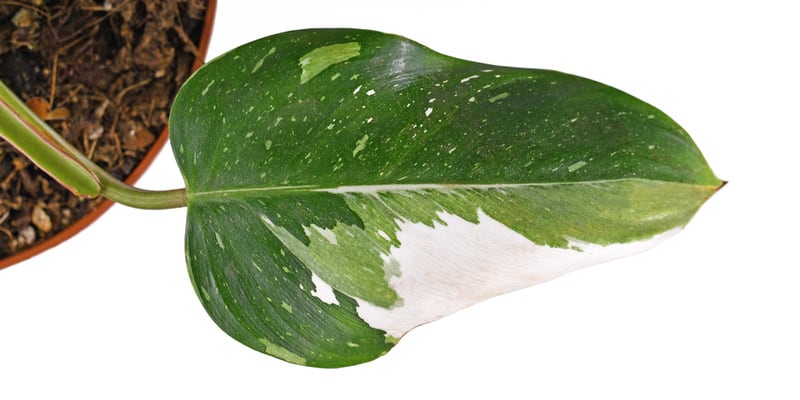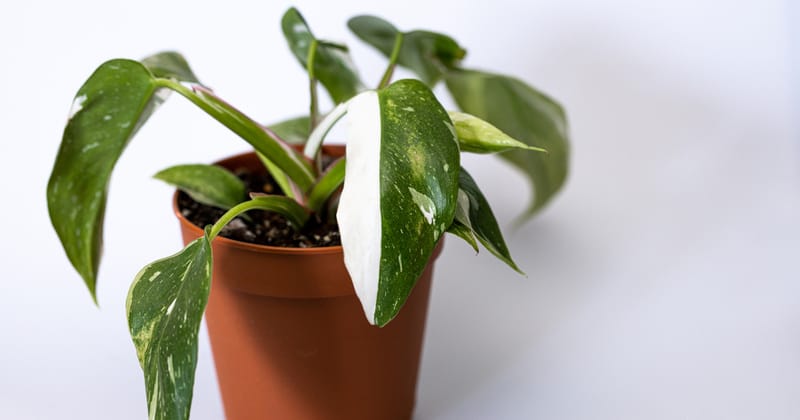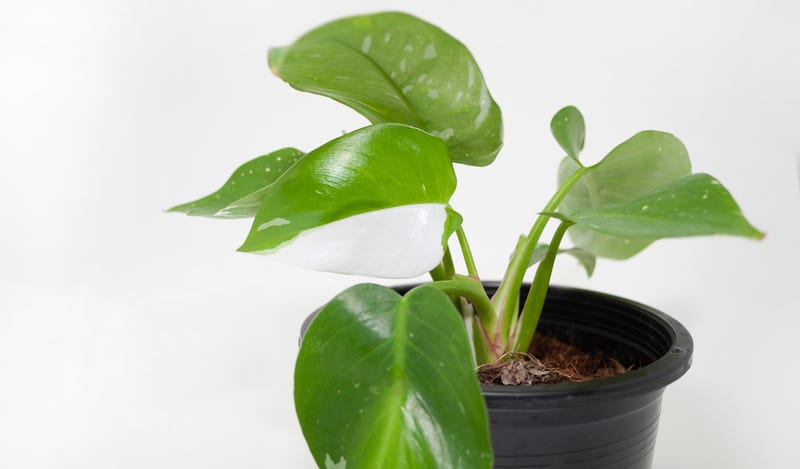The White Princess Philodendron is a variety with dazzling green and white foliage. Take this gorgeous plant indoors – it thrives best under bright indirect sunlight.
Its low-maintenance nature makes it perfect for first-time plant parents. Just place your Philodendron White Princess in a humid environment to ensure that it stays plump and thriving.
You may also want to keep little humans and fur-friends away from it.
A White Princess may look harmless, but she has a few tricks up her sleeve: this Philodendron is toxic when ingested.
How to identify a Philodendron White Princess
Many Philodendron plants may strike you as one and the same at first glance. But take a closer look and you’ll see that there are differences.
So what makes a White Princess, well, a White Princess?
Let’s start with how she looks. There’s no mistaking the white variegation on a White Princess’ leaves.
The shape of her foliage is long and elegant, and her stems are green and fresh-looking.
A White Princess Philodendron has underground and aerial roots, both of which enable her to get nutrients from her environment.
Care for your White Princess well and this statuesque beauty can reach a height of 1m.
The Philodendron White Princess vs. other Philodendron varieties
Other Philodendron varieties bear a distinct resemblance to the White Princess, but there can only be one true royal.
To know if yours is the real deal, there are things you can check: leaf variegation, stem colour and leaf size.
While all plants from the Philodendron genus belong to the Araceae family, the White Princess is one of the cultivars with striking white variegation on its leaves.
The other varieties with white marks are the Philodendron White Knight and White Wizard.

Now it’s easy to mistake one for the other, but leaf size and stem colour can tell you which is which.
Compared to the White Princess’ narrow foliage, the White Wizard and White Knight have broad leaves. A White Knight also has reddish-brown stems, unlike the White Princess’ green stems.
You can also differentiate the White Princess from the other two white Philodendrons by her structure.
She is considered a self-heading plant and can support herself, whereas the Knight and Wizard are trailing climbers.
Another indicator is cost. Because the White Wizard is a fast grower and the easiest to propagate, it has the lowest price point among the 3 varieties.
When checking for your plant’s authenticity against the Rojo Congo or Imperial Gold varieties, take a look at the leaf size as well. A White Princess has smaller leaves than the other two Philodendrons.
There’s no contest when you’re pitting a Princess against a Wizard and Knight, but what happens when you place two aristocratic indoor plants side by side?
We’re talking about the White Princess’ ultimate rival, the Philodendron Pink Princess. Both are stunning in their own right!
But, as their names suggest, a White Princess has white variegations, while a Pink Princess has pink variegations.
How to care for a White Princess Philodendron

The White Princess may be a slow grower, but she’s not a fussy indoor plant to maintain.
These are the elements that your White Princess needs to thrive:
Light
Bright, indirect light is the key to your White Princess’ beautiful white variegations. Too much light can cause your plant’s leaves to turn yellow.
Not enough light, on the other hand, can result in thin gangly appendages. When totally deprived of light, your White Princess can become unhealthy and die.
When you start to see yellowing leaves or unhealthy-looking foliage, transfer your White Princess to an area with the right light conditions.
Soil
Moist but well-draining soil is the best soil type to plant your White Princess in.
Temperature
A temperature range of 18-23C is the ideal range for your White Princess.
Anything above or below this range can cause your plant’s health to deteriorate.
Humidity
A White Princess is not a drought-resistant plant – it needs an environment with medium to high humidity to be at its best.
If the dry air in your home is causing your White Princess to look thin and lacklustre, don’t worry. There are many ways to solve this problem.
Place your White Princess in the bathroom and see it regain its vigour. This part of your home has a higher moisture level in the air than in other indoor areas.
Alternatively, you can mist your plant using a spray bottle. A twice-a-week misting can do wonders in improving the humidity of your White Princess’ environment.
During dry winter months, mist once every 10 days to provide adequate moisture for your plant. Use the fine mist setting for a gentle spray.
Another way to improve the humidity in your home is to make a pebble tray to go underneath your White Princess.
When the water in the tray evaporates, it creates a micro-environment around your plant. This provides enough moisture that your White Princess needs to thrive.

Watering
There are two instances when you should water your White Princess Philodendron:
- When the top layer of the soil is dry
- When the leaves start to droop
Revive your lifeless-looking White Princess by watering thoroughly, then allowing the water to drain out completely. Your plant should not undergo dry spells for a long period of time.
A water conundrum to consider: too much water can also cause your plant’s leaves to droop! Take care not to water more than you should, and to avoid waterlogging.
While it’s tempting to spoil your White Princess, the principle of ‘not too much, not too little’ works best for this plant.
Fertilising
Fertilising boosts plant growth and keeps it healthy and resistant to disease.
These are the best times to fertilise your White Princess:
- Fertilise monthly during spring and summer
- Fertilise every 6 to 8 weeks during fall and winter
Use a balanced liquid houseplant fertiliser to ensure the best growth for your White Princess.
Pest control
The most common pests that infest a White Princess Philodedron are aphids and mealybugs. A sign that your plant has aphids is yellow contorted leaves.
Aphids also secrete a sticky substance that damages your plant.
Mealybugs, on the other hand, can kill your plant by sucking the fluid. You’ll find mealybugs near stems or newly grown leaves.
Remove aphids from your White Princess by wiping them off with a cotton swab. This method is effective for light infestations. For denser aphid colonies, submerge the leaf entirely in water to dislodge the insects.
To remove mealybugs from your plant, wipe them off with a cotton swab dipped in 70% isopropyl alcohol. This method does have some risks, so it’s best to do a spot-test on a small patch of your plant’s leaves to be sure.
If you’re hesitant about treating your White Princess’ pest problem or unsure about what’s causing your plant’s poor health, the best solution is to consult gardening professionals.
They will be able to properly diagnose the problem and provide you with an effective remedy that will bring your White Princess back to health.

